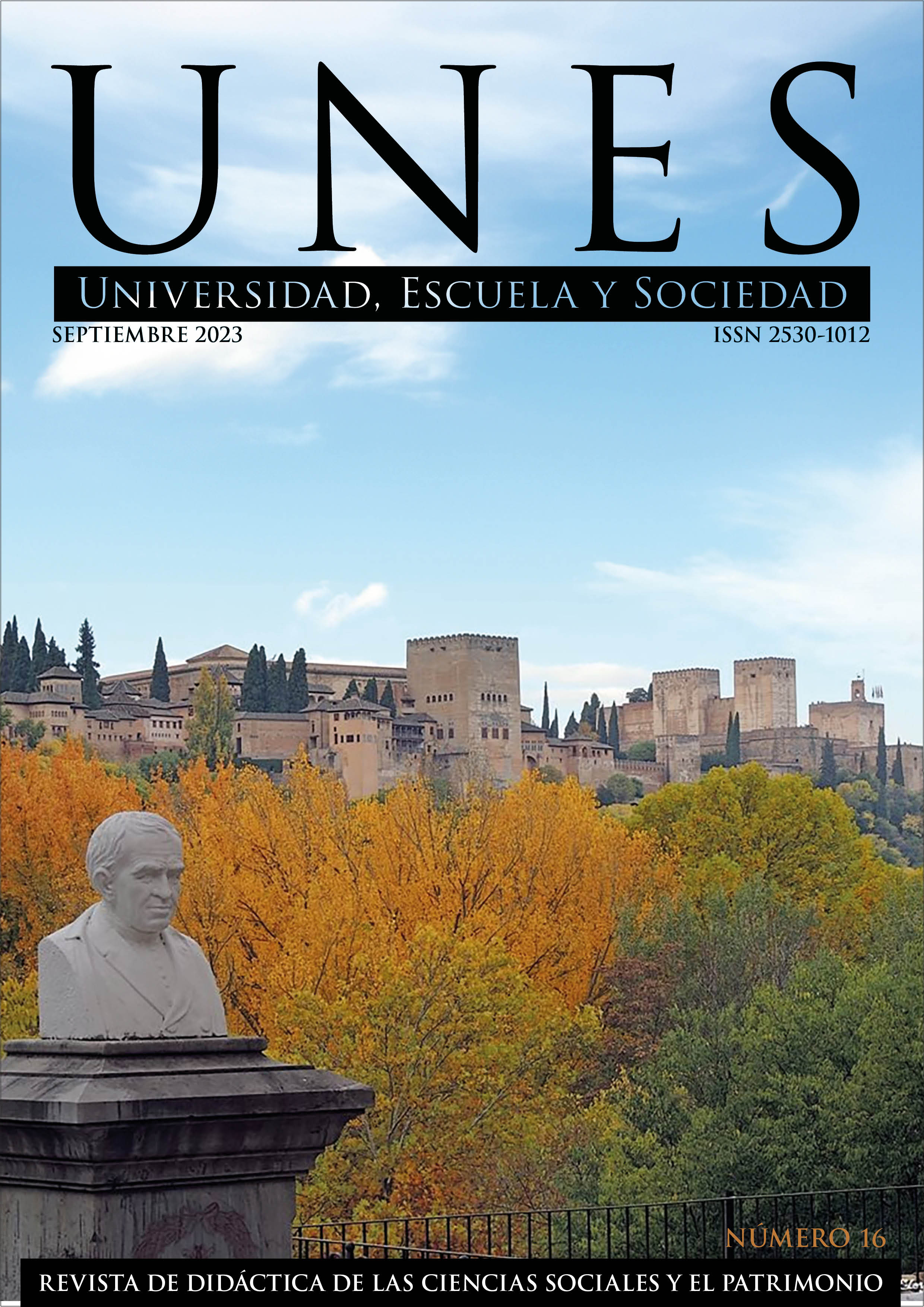LIDAR XXI: técnicas topográficas del siglo XXI aplicadas a la detección de yacimientos arqueológicos ocultos por vegetación
DOI:
https://doi.org/10.30827/unes.i16.28660Palabras clave:
Formación profesional superior, LIDAR, Arqueología, Topografía, DronesResumen
LIDAR XXI es un proyecto educativo, que nace con la finalidad de incluir dentro de la formación profesional del ciclo formativo de proyectos de obra civil, los últimos avances tecnológicos relacionados con el sector de la cartografía y la topografía. Fue seleccionado entre los 30 proyectos ganadores más innovadores de formación profesional a nivel nacional, de los 180 presentados a la convocatoria Caixabank Dualiza del curso 2021-2022. La participación en este programa supuso recibir la financiación necesaria para su ejecución y desarrollo. El proyecto tiene una doble finalidad, por un lado, aportar innovación a la formación profesional incorporando tecnología de última generación y por otro, realizar una investigación en colaboración con el laboratorio de arqueología Biocultural-MEMOLab de la universidad de Granada, determinando la optimización de la aplicación LIDAR a la detección de yacimientos arqueológicos.
Descargas
Citas
AlphaAir 450 UAV LIDAR SOLUTIONS MAPPING & GEOSPATIAL. (2022).
Căţeanu, M., & Arcadie, C. (2017). Als for terrain mapping in forest environments: An analysis of LIDAR filtering algorithms. EARSeL EProceedings, 16(1), 9–20. https://doi.org/10.12760/01-2017-1-02
Lozić, E., & Štular, B. (2021). Documentation of Archaeology-Specific Workflow for Airborne LIDAR Data Processing. Geosciences, 11(1), 26. https://doi.org/10.3390/geosciences11010026
Martín Talaverano, R. (2014). Documentación gráfica de edificios históricos: principios, aplicaciones y perspectivas. Arqueología de La Arquitectura, 0(11), e011. https://doi.org/10.3989/arq.arqt.2014.014
Puliti, S., Ene, L. T., Gobakken, T., & Næsset, E. (2017). Use of partial-coverage UAV data in sampling for large scale forest inventories. Remote Sensing of Environment, 194, 115–126. https://doi.org/10.1016/j.rse.2017.03.019
Rizaldy, A., Persello, C., Gevaert, C. M., & Oude Elberink, S. J. (2018). FULLY CONVOLUTIONAL NETWORKS FOR GROUND CLASSIFICATION FROM LIDAR POINT CLOUDS. ISPRS Annals of the Photogrammetry, Remote Sensing and Spatial Information Sciences, IV–2(2), 231–238. https://doi.org/10.5194/isprs-annals-IV-2-231-2018
Rodriguez-Bulnes, J., Benavides Lopez, J. A., Romero Pellitero, P., Martin Civantos, J. M., & Rouco Collazo, J. (2022). The documentation of archaeological heritage through aerial photogrammetry and UAS-based LIDAR: the case study of the Espique valley (La Peza, Spain). Disegnarecon. https://doi.org/https://doi.org/10.20365/disegnarecon.29.2022.12
Rouco Collazo, J., Benavides López, J. A., & Martén Civantos, J. M. (2020). Falling from the sky. Aerial photogrammetry and LIDAR applied to the Archaeology of Architecture and Landscape: two fortifications from the Alpujarra (Granada, Spain).
Yang, B., Huang, R., Dong, Z., Zang, Y., & Li, J. (2016). Two-step adaptive extraction method for ground points and breaklines from LIDAR point clouds. ISPRS Journal of Photogrammetry and Remote Sensing, 119, 373–389. https://doi.org/10.1016/j.isprsjprs.2016.07.002
Zhang, Wu, & Yang. (2019). Forests Growth Monitoring Based on Tree Canopy 3D Reconstruction Using UAV Aerial Photogrammetry. Forests, 10(12), 1052. https://doi.org/10.3390/f10121052
Zhang, H., Aldana-Jague, E., Ois Clapuyt, F., Wilken, F., Vanacker, V., & Oost, K. van. (2019). Evaluating the Potential of PPK Direct Georeferencing for UAV-SfM Photogrammetry and Precise Topographic Mapping. https://doi.org/10.5194/esurf-2019-2
Zietara, A. M., & Skogseth, T. (2017). Creating Digital Elevation Model (DEM) based on ground points extracted from classified aerial images obtained from Unmanned Aerial Vehicle (UAV).
Descargas
Publicado
Cómo citar
Número
Sección
Licencia
Derechos de autor 2023 Jesús Rodríguez-Bulnes, Emilio García Soto, José Manuel López Funes

Esta obra está bajo una licencia internacional Creative Commons Atribución-NoComercial-CompartirIgual 4.0.
Los autores que publican en esta revista están de acuerdo con los siguientes términos:
Los autores conservan los derechos de autor y garantizan a la revista el derecho de ser la primera publicación del trabajo al igual que licenciado bajo una licencia de Creative Commons Reconocimiento-NoComercial-CompartirIgual 4.0 Internacional que permite a otros compartir el trabajo con un reconocimiento de la autoría del trabajo y la publicación inicial en esta revista.
Los autores pueden establecer por separado acuerdos adicionales para la distribución no exclusiva de la versión de la obra publicada en la revista (por ejemplo, situarlo en un repositorio institucional o publicarlo en un libro), con un reconocimiento de su publicación inicial en esta revista.
Se permite y se anima a los autores a difundir sus trabajos electrónicamente (por ejemplo, en repositorios institucionales o en su propio sitio web) antes y durante el proceso de envío, ya que puede dar lugar a intercambios productivos, así como a una citación más temprana y mayor de los trabajos publicados (Véase The Effect of Open Access) (en inglés).
Los autores han respetado la política de autoría de esta revista






 ISSN-e: 2530-1012
ISSN-e: 2530-1012









